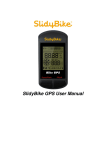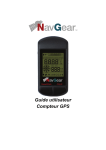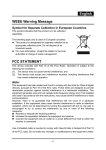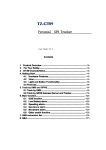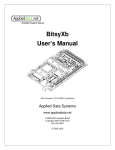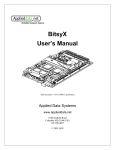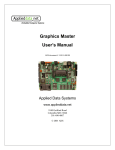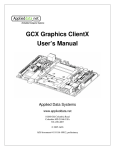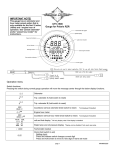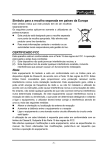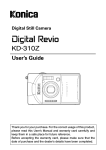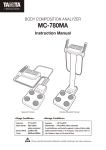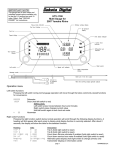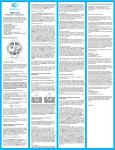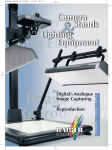Download MERCURY 100 User Manual - produktinfo.conrad.com
Transcript
MERCURY 100 User Manual Disclaimer ............................................................................................................................2 Warning ...............................................................................................................................3 About GPS...........................................................................................................................4 Thank You for Choosing the MERCURY 100.......................................................................5 Conditions for Use: ..............................................................................................................5 1. Introduction............................................................................................................6 1.1 1.2 1.3 1.4 Package Contents:......................................................................................6 Maintenance: ..............................................................................................6 Charging: ....................................................................................................6 Introduction to the Hardware.......................................................................7 2. 1.5 System Requirements.................................................................................7 1.6 Basic Specifications ....................................................................................8 1.7 Installing the device cradle..........................................................................9 USB Driver Installation ........................................................................................13 3. Bundled Software Installation: .............................................................................15 4. 5. 6. Bundled Software (MERCURY 100) Introduction: ...............................................16 LCD Icon Guide ...................................................................................................29 Instructions ..........................................................................................................32 6.1 Start ..........................................................................................................32 6.2 6.3 6.4 6.5 6.6 7. Bike Mode.................................................................................................32 Waypoint Mode .........................................................................................35 Route Mode: .............................................................................................36 Other Functions: .......................................................................................38 Setup Mode: .............................................................................................39 6.6.1 Bike Mode Setup:..............................................................................39 6.6.2 Waypoint Mode Setup:......................................................................40 6.6.3 Route Mode Setup: ...........................................................................41 Troubleshooting...................................................................................................42 Disclaimer MERCURY 100 User Manual Version: V1.0 Compass Systems Corp. E-mail: [email protected] This user manual is only intended for the personal use of the purchaser. The purchaser may not copy or otherwise publish any part of this user manual for any purpose, in any form or through any method, be it electronic or mechanical, photographic records included, except with the prior consent in writing of Compass Systems. Compass Systems reserves the right to modify without notice any of the information contained within this user manual. Compass Systems reserves the right to change, improve or modify its product or its content at any time without having to notify any person or organization. © Copyright 2009, Compass Systems Corp. All rights reserved. 2 Warning The correct and safe use of the MERCURY 100 requires the user's familiarity with certain items of knowledge. Please read through this user manual before operating the device. The MERCURY 100 is only intended to be an auxiliary device and can't be held legally liable for any accidents resulting from errors in measurement through the user's incorrect operation or use of the MERCURY 100. 3 About GPS GPS (Global Positioning System) is a satellite navigation system developed by the U.S. Department of Defense. GPS consists of 32 satellites orbiting around 11,000 miles above the surface of the Earth. These satellites travel at speeds that allow them to orbit the planet twice a day and emit a low-powered radio signal. These signals are received and recorded using five ground stations with extremely accurate clocks. By using these extremely accurate clocks, the ground stations can determine with great precision the position of every satellite in their orbit. Your GPS receiver is capable of "reading" the signals transmitted by these satellites. By knowing the position and distance of al least 4 satellites, it's possible to accurately calculate the receiver's current latitude, longitude and elevation. WAAS enhances the accuracy of your GPS. WAAS stands for Wide Area Augmentation System and was developed by the Federal Aviation Administration to augment the accuracy of GPS for aviation use. It consists of additional ground stations that are placed at specific locations where the exact coordinates are known. When used with a master station, the accuracy of satellite positioning signals can be improved to almost three meters. The MERCURY 100 must scan and detect signals from at least 3 such satellites in order to calculate your current location and movement. The MERCURY 100 is designed for recreational use only. Please do not use this product for industrial or professional surveying. 4 Thank You for Choosing the MERCURY 100 The lightness, compactness and user-friendly interface make the Mercury 100 an excellent auxiliary navigation aid when cycling. It can not only give you a better understanding of your cycling activities but also effectively manage cycling routes. The MERCURY 100 provides only the information you need and nothing else. It is suitable for use by all cyclists and is designed to be the easiest to use cycling GPS in the world. Its satellite receiver works all around the world and will provide you with many years of useful service. This manual will introduce you to the use and features of the MERCURY 100 so you can optimize performance and take care of the device as well. To ensure that you achieve the best performance and service life from the MERCURY 100, please read carefully through these instructions before use. Conditions for Use: The MERCURY 100 is not designed for indoor or underwater use. The device uses GPS satellites to calculate distances and is designed to serve as an auxiliary navigation aid for bicycles between the temperatures -10°C to +60°C. Using the MERCURY 100 for cycling activities therefore allows the device to deliver optimum performance. If you find that any of the standard accessories listed in this manual are missing or damaged, please contact your local distributor or retailer. 5 1. Introduction 1.1 Package Contents: Before using this product, please check that the following items were included within the package. If there are any missing items, please contact the distributor you purchased this product from immediately. 1. 2. 3. 4. 5. MERCURY 100, internal rechargeable lithium battery. AC charger. User Manual USB Cable. Software CD-ROM 6. 7. 8. Bicycle Mount. Protective Cover. Strap. 1.2 Maintenance: 1. Do not attempt to disassemble the MERCURY 100. 2. 3. This device contains no user-repairable parts. Please store the MERCURY 100 out of direct sunlight or high temperatures. 1. 1.3 Charging: Connect one end of the USB cable to the rubber covered port on the base and the other end into the AC charger. Plug the AC charger into a power socket. 2. The device can be on or off while charging. A battery icon will appear while charging to show the current progress. The number of blocks will increase over time and when 3. 4. fully charged, the icon will show three blocks. It takes 4~5 hours to fully recharge the battery. A fully charged MERCURY 100 can operate up to 20 hours with normal use and with the backlight turned off. This, however, is still subject to usage and environmental 5. conditions. The battery does not need to be fully discharged before recharging. If there is no satellite signal, do not leave the the battery to charge overnight. 6. The best and the fastest way of recharging the device is to turn the power off before charging. 7. Once the device is fully charged, please put away the USB cable and AC charger, then close the rubber cover over the port so it is ready for use next time. 8. To be sure the data is secured, please do charge your battery when the battery indicate in block 1 . 6 1.4 Introduction to the Hardware Power/Mode select button Select/Adjust button Start/Stop/Mark/Reset USB Port 1. Power/Mode select button: Use to turn power on(Hold on 1sec)/off(Hold on 3sec) and switch between operating modes(Push). 2. Select/Adjust button: Switch display functions / configure parameters(Push)and setup mode(Hold on 3sec). Start/Stop/Mark/Reset button: Turns the recorder(Push)/backlighton/off(Hold on 3sec), marks locations and resets parameter settings(Push). 3. 1.5 System Requirements Please check that your computer meets the following system requirements before installing the driver program and software bundled with this product. 1. 2. Pentium III 8000MHz CPU or above USB Interface 3. 4. 5. 6. 512MB RAM CD-ROM drive Windows Vista(service pack 1)/XP/2000 operating system Network bandwidth download and upload upward 2M 7 1.6 Basic Specifications Interface Graphical Display WayPoint 4 Route 1 Turn Point 99 Receiver Chip High sensitivity receiver chip Positioning Time Hot Start < 1 sec Warm Start < 38 sec Cold Start < 42 sec Data Refresh Rate Once every second Positioning Accuracy Single unit positioning with no SA interference <10M Antenna Internal Power Supply Battery Type Rechargeable Lithium Battery (820mAh) Endurance 20 hours under normal use with backlight off Interface USB Interface (can connect to PC) Yes Size 91.1(L)x 46.1(W) x 23.9(D)mm Mass <100g Display Size 32x38.25mm Water Resistance IPX7 (Waterproof at depths of up to 1m for up to 30 minutes) -10°C to + 60°C Operating Temperature Range 8 1.7 Installing the device cradle Part List: Device cradle *1 Rubber pad* 1 Cable tie *2 Installing the device cradle on the horizontal bar 1. As shown in the figure, insert the device cradle into the rubber pad. 2. As shown in the figure, insert the two cable ties into the device cradle. 9 3. Fasten the cable ties around the horizontal bar of the bicycle. 4. Cut off the extra cable ties. 5. Upon completion, insert MERCURY 100 along the direction indicated by the arrow in the figure. 10 Installing the device cradle on the vertical bar 1. As shown in the figure, insert the device cradle into the rubber pad. 2. As shown in the figure, insert the two cable ties into the device cradle. 3. Fasten the cable ties around the vertical bar of the bicycle. 11 4. Cut off the extra cable ties. 5. Upon completion, insert MERCURY 100 along the direction indicated by the arrow in the figure. 12 2. USB Driver Installation Do not connect the MERCURY 100 to the PC 1. Start Windows OS. 2. Inset the Installation CD into CD ROM drive. 3. The installation program will start automatically. 13 4. Click “Driver 2000/XP”或”Driver Vista” and follow the program’s directives to finish the procedure. Connect the MERCURY 100 to the PC (1) Connect one end of the USB cable to the USB port on the PC. (2) Connect the other end of the USB cable to the port on the base of the MERCURY 100. (3) Hold down the power button on the MERCURY 100 for 2 seconds until it turns on. (4) The system will automatically detect and identify the MERCURY 100. 14 3. Bundled Software Installation: (1) Start Windows OS. (2) Inset the Installation CD into CD ROM drive. (3) The installation program will start automatically. (4) Click” MERCURY 100”, the installation program will start automatically (5) If it can’t install, please download the Windows Installer 4.5 from www.microsoft.com and install MERCURY 100 after installed Windows Installer 4.5 15 4. Bundled Software (MERCURY 100) Introduction: Attention: As this software needs to connect to Google Map, make sure that the network is working smoothly before using. This will result in better Google Map performance. 1. 2. Start the software: Start -> Programs -> MERCURY 100 -> MERCURY 100 Utility Software startup screen: 3. Device information and settings (1) Firmware version (2) Device serial number (3) Travel time (4) Travel distance (8) Calories (9) Datalog records (10) Length unit (11) Temperature unit (14) Time zone (15) Time zone reference (16) Close the device information window (5) Odometer: (6) Maximum velocity (7) Average velocity (12) Personal Weight (13) Datalog interval time(1~3600 secs) (17) Update the settings 16 4. Setting up the POI (point of interest) Startup screen By default, four nav points A, B, C and D are shown on screen. The user can zoom in on the Google Map, move the four nav points to where they want to go then upload the results to the device. Download the POI from the device to the map: click the icon to download the POI saved in the device to the map. Besides, you can save the POI to your desktop computer by clicking the icon for others to upload to another MERCURY 100. Click the download icon to download the POI of the device to the map. 17 Click the save icon to save the POI on the map to the proper folder on your computer. You may set the POI on the map by moving the POI icon (A~D) around the map and later upload the POI to the device. Click the POIs (A~D) with your mouse and move them to your desired places. 18 Click the upload icon You may open to upload the POIs on the map to the device. the POI files saved in your computer and upload Click the open icon them to the device. to open a POI file saved in your computer. 19 Click the upload icon to upload the POIs on the map to the device. 20 5. Setting up the TurnPoint (Turn by Turn) Using this function, the user can edit up to 99 turning points, meeting points or other locations into their planned route. The nav points can also be organized into separate routes, so 1~20 is for route 1, 22~30 is for route 2, and so on. These can then be uploaded to the device and used for navigation. The world's most well-known cycling routes can also be downloaded from www.mybikegps.com to the user's computer. The data can be opened using this software and loaded into Google Map. From there, it can be uploaded to the device. All routes are provided by cyclists from around the world and provided for reference only. Startup screen Download the TurnPoint from the device to the map: click the icon to download the TurnPoint saved in the device to the map. As well, you can save the TurnPoint to your desktop computer by clicking the icon for others to upload to another MERCURY 100. 21 Click the download Click the save icon icon to download the TurnPoint of the device to the map. to save the TurnPoint on the map to a proper folder on your computer. You may edit the TurnPoints (1~99) on the map by adding on the map and later upload the TurnPoints to the device. 22 or deleting TurnPoints Click the add icon to add new TurnPoints. and click the Turnpoints you want to delete. To remove TurnPoints, click the delete icon 23 Click the upload icon You may open to upload the TurnPoints on the map to the device. the TurnPoint files saved in your computer and upload them to the device. Click the open icon to open a TurnPoint file saved in your computer. 24 Click the upload icon Delete to upload the TurnPoints on the map to the device. all the TurnPoints Click the clear all icons to remove all the TurnPoints on the map. 25 When all the TurnPoints have been deleted, the screen shows the world map. 26 6. Setting up the route Click the download icon to download the route saved on the device. (1) Download all trace history on the device to the Mercury 100. (2) Clear all trace history from the device. (3) Clear downloaded trace history (remove single entry). (4) Select a trace history for display on Google Map. (5) Trace history details. (6) Distance/speed analysis for each trace history. To clear the route data saved on the device, click the clear icon Click save icon . to save the route downloaded from the device to your desktop PC. 27 7. Miscellaneous On all setup screens, click the icon to enter the device information/setup screen. On the map screen, click the map/satellite/mixed buttons to switch the map display mode. When the network resources are not enough, map mode is suggested. 28 5. LCD Icon Guide 1. Battery: Divided into 3 blocks. During normal use, this shows the amount of power remaining. When charging, the blocks cycle from the bottom up, going from 0 to 3 blocks. Once fully charged, the icon stays at 3 blocks. 2. Satellite: Indicates the GPS positioning status. Blinking means no fix or scanning for satellites. Constant means position acquired or still acquiring fix. 3. 4. Time: Shows the cumulative riding time. When Reset to 00:00:00, it will start counting riding time when the user starts riding (reaches 5km/hr). If riding time exceeds 99:59:59, it hold to 99:59:59. TOA: Time of Arrival. When switched to Waypoint and Route display mode, it shows the estimated time of arrival. 5. 6. 7. 8. 9. :Time display. :Shows the time for the current region. Taiwan, for example, must be set to UTC +8hr based on the GPS reference time. If GPS fix not acquired, then the time display changes to --:--:--. DTG: Distance to GO. When switched to Waypoint and Route display modes, shows the estimated direct line distance. ODO: Odometer. Shows the current distance traveled in MI (miles) or KM (kilometers). DST: Distance. Displayed in MI or KM. Resets to zero when device is turned on or off. 10. AZM: Azimuth. Reads the current azimuth from the e-compass and displays it in 29 degrees (°) and as a direction on the compass icon . 11. TMP: Temperature. Shows the current temperature in ℃ or ℉, This temperature is the electronic detection, because of the chip characteristic, under the temperature difference environment, needs 15~20 minute change current temperatures. 4 Digit Display. 12. :Used to display current azimuth, AZM, SLP or TMP. 13. :Switch between KM (Kilometer) or MI (Mile) for displaying the distance in 14. Bike, Waypoint or Route mode. 15. "Eight Direction" Compass: When showing the azimuth, each direction has a range of ±22.5°. For example, the Northeast (45°) direction includes all bearings between 22.5°~67.5°. 16. MAX: Maximum speed. Shows the maximum riding speed on record as mi/h or km/h. 17. AVG: Average speed. Shows the average riding speed on record as mi/h or km/h. 18. 3 Digit Display. Calorie Unit: The Calorie display shows Kcals. If less than Kcal, it switches to 19. cal. 20. Speed Unit: The unit speed is to be measured in. Switch instantaneously between 21. 22. . Backlight indicator. Recorder storage indicator: Divides the total number of entries into 6 parts. Increments by 1 block for each sixth of total storage. 23. Bike Mode: Switching to this mode will show information about current ride. 24. WayPoint indicator: Press the Select button to cycle between 30 waypoints A, B, C and D. 25. Route indicator: Shows the location of the next destination. 26. Setup Mode indicator: Changes to Setup Mode when user enters setup mode. 27. If the data surpasses the maximum value which LCD may display, it display the maximum value . The user may use MERCURY 100 Utility to get the true information. 31 6. Instructions 6.1 Start Hold the power button 1sec,the length of time required to acquire a GPS fix after starting this device may vary: Normal Approx. 2 minutes A. First use after purchase (may need to update Approx. 15~45 satellite information). sec. B. Frequent use in Taiwan. Special Approx. 5 minutes A. Device has not been used for over 3 months. B. You are over 800km away from the location where you last used this device. Blinking icon means no fix or scanning. A constantly lit icon means fix acquired or being acquired. When there is no GPS fix, time is displayed as --:--:--, distance as ---- and speed as ---. 6.2 Bike Mode This is the default mode upon startup. There are three main modes, these being Bike Waypoint and Route , . Pressing on the "Power/Mode" button cycles between Bike, WayPoint and Route modes. 1. By default, the device starts in mode. The first page shows the following items: (1) Current riding time, shown as Time. (2) Total cumulative distance ridden, shown as ODO in MI or KM. (3) Current speed, shown as mi/h or km/h. (4) Arrow pointing north. 32 2. After pressing the Select button, the displayed items become: (1) Current riding time, shown as Time. (2) Distance ridden so far, shown as DST in MI or KM. (3) Current speed, shown as mi/h or km/h. (4) Arrow pointing north. 3. After pressing the Select button a second time, the displayed items become: (1) Current riding time, shown as Time. (2) Distance ridden so far, shown as DST in MI or KM. (3) Maximum speed, shown as mi/h or km/h. (4) Arrow pointing north. 4. After pressing the Select button a third time, the displayed items become: (1) Current riding time, shown as Time. (2) Distance ridden so far, shown as DST in MI or KM. (3) Average speed, shown as mi/h or km/h. (4) Arrow pointing north. 33 5. After pressing the Select button a fourth time, the displayed items become: (1) Current Time in 24-hour format: Shown as . (2) Current azimuth and arrow pointing north: Shown as AZM and °. (3) Current speed, shown as mi/h or km/h. (4) Arrow pointing north. 6. After pressing the Select button a fifth time, the displayed items become: (1) Current riding time, shown as Time. (2) Current temperature, shown as TMP in °C or °F. (3) Current calories, shown as cal if under 1Kcal and as Kcal otherwise. (4) Arrow pointing north. 34 6.3 Waypoint Mode In Bike mode, press the "Power" button switches to Waypoint mode. At startup, waypoint A is displayed. Press the Select button to cycle through waypoints A~D. When the "Power" button is pressed to exit or access this mode, it will remember which waypoint (A~D) was last displayed. (1) Estimated time of arrival shown as TOA. (2) Estimated direct line distance shown as DTG in MI or KM. (3) Current speed, shown as mi/h or km/h. (4) Arrow pointing towards the destination. Set Waypoint Holding down the "Select" button for 3 seconds, opens the display and makes the current waypoint blink. For example, if waypoint B is currently displayed, waypoint B along distance display will start blinking. Pressing the with DTG and "Reset/Mark" button (i.e. "Start/Stop" button) resets the waypoint. The DTG for the newly marked waypoint should be 0.00. Now hold down the "Select" button for 3 seconds to close the Setup mode and display. The waypoint has now been set and the next time you wish to ride to waypoint B, it will direct you to the marked waypoint. Marking a new waypoint will override the previously marked waypoint. When the rider is within 50m of waypoint A, B, C or D, a buzzer will sound 5 times (lasting 1 second each time at 0.5 second intervals). The arrow will also blink each time the buzzer sounds. The user can press any button to stop the buzzer or wait for it to finish and the arrow will continue blinking. When within 10m of the waypoint, all eight points of the compass icon will start blinking and only revert to normal when the rider is more than 10m away from the waypoint. This item can only be calculated or displayed when GPS coordinates are available. When GPS fix has not been acquired, time is shown as --:--:--, distance as ---- and speed as ---. If speed is less than 5km/hr, time is shown as --:--:--. 35 6.4 Route Mode: Press the "Select" button to switch up waypoint from 01- 99 and press the “Start/Stop” button to switch down waypoints from 99- 01. When the rider approaches within 50m of the current destination ID, a buzzer will sound 5 times (lasting 1 second each time at 0.5 second intervals). The arrow will also blink each time the buzzer sounds. The user can press any button to stop the buzzer or wait for it to finish and the arrow will continue blinking. When within 10m of the destination, all eight points of the compass icon will start blinking and the device will automatically move to the next destination ID. If destination ID is 50, it will continue blinking just like Waypoint mode. When leaving or entering Route mode, the device will remember the last destination ID displayed. Press both “Select” and “Start/Stop” button to switch to Route Backward Mode, press “Select” and “Start/Stop” button again to Route Forward Mode. If separate routes were created by the user (e.g. points 1~20 are for route 1, 22~30 are for route 2), the device will guide the user to point 20 of route 1 and then stop. The user must then press the Select button and skip to point 22 to enable navigation for route 2. When GPS fix has not been acquired, time is shown as --:--:-- and distance as ----. If speed is less than 5km/hr, time is shown as --:--:-- 36 (1) Estimated time of arrival shown as TOA. (2) Estimated direct line distance shown as DTG in MI or KM. (3) Current waypoint ID between 01~99. (4) Arrow pointing towards the destination. Mark Route In Route mode (destinations 01~99), hold down the "Select" button for 3 seconds opens the display. The current destination (01~99) will also start blinking. For example, if currently set to destination ID 21, the number 21 will flash during Setup mode. The blinking items include , DTG and distance reading. Pressing the "Reset/Mark" button (i.e. "Start/Stop" button) the destination will be reset and its coordinates marked. The calculated DTG should be 0.00. Use this method to mark all 99 waypoints. 37 6.5 Other Functions: 1. Start or stop recorder Pressing the "Start/Stop" button in user mode turns the icon on or off. This also turns the recorder on and off as well. The recording intervals can be configured through the bundled software. For more information, please refer to the software instructions. 2. Turn LCD backlight on or off Holding down the "Start/Stop" button for 3 seconds in user mode turns the off. This also turns the LCD backlight on or off as well. 38 icon on or 6.6 Setup Mode: In Bike mode, Waypoint mode or Route mode, holding down the "Select" button for 3 seconds switches to Setup Mode. Bike Mode: Time, DTG, MAX and AVG, Kcal, ODO Reset, Cycle Unit. Waypoint Mode: Reset Waypoints A, B, C, D (Mark Waypoint), Cycle Unit. Route Mode: Reset Destinations 01~99 (Mark Waypoint), Cycle Unit. 6.6.1 Bike Mode Setup: Holding down the "Select" button for 3 seconds in this user mode opens the Blinking items include: , Time, display. time display, DST, distance display, MAX, AVG, speed display, Kcal. In Setup Mode, pressing the "Reset/Mark" button (i.e. "Start/Stop" button) resets everything to 0. The 4-digit display is set to 0.00 and 3-digit display is set to 0.0 as well while continuing to blink. The items reset include: (1) Time, Distance. (2) Maximum and Average Speed. (3) Calories. 1. Pressing the "Select" button for the first time Blinking items include: ODO and distance display. Pressing the "Reset/Mark" button (i.e. "Start/Stop" button) resets the odometer. After reset it continues to blink and display the number 0.00. 39 2. Pressing the "Select" button for the second time Blinking items include: MI or KM, mi/h or km/h. If MI is blinking then mi/h will be blinking as well. If KM is blinking then km/h will be blinking. Pressing the "Reset/Mark" button (i.e. "Start/Stop" button) switches between metric or imperial units and they will continue to blink. If the unit of measurement is switched to imperial or metric, other functions' unit of measurement will switch as well. Pressing the "Select" button for a third time reverts back to the first blinking item. Under any display mode, holding down "Select" for 3 seconds closes Setup mode and the display then reverts back to user mode. 6.6.2 Waypoint Mode Setup: In Waypoint modes A~D, hold down the "Select" button for 3 seconds opens the display. The current waypoint will also start blinking. For example, if currently set to Waypoint B, B will flash during Setup mode. The blinking items include DTG distance reading. Pressing the "Reset/Mark" button (i.e. "Start/Stop" button) resets the waypoint and marks the current coordinates. The calculated DTG should be 0.00. Once reset it will continue blinking. 1. Pressing the "Select" button for the second time Blinking items include: MI or KM, mi/h or km/h. If MI is blinking then mi/h will be blinking as well. If KM is blinking then km/h will be blinking. Pressing the "Reset/Mark" button (i.e. "Start/Stop" button) switches between metric or imperial units and they will continue to blink. If the unit of measurement is switched to imperial or metric, other functions' unit of measurement will switch as well. 2. Pressing the "Select" button for a third time reverts back to the first blinking item. Under any display mode, holding down "Select" for 3 seconds closes Setup mode and the display then reverts back to user mode. 40 6.6.3 Route Mode Setup: In Route mode (destinations 01~99), holding down the "Select" button for 3 seconds opens the display. The current destination (01~99) will also start blinking. For example, if currently set to destination ID 21, the number 21 will flash during Setup mode. The blinking items include , DTG and distance reading. By pressing the "Reset/Mark" button (i.e. "Start/Stop" button), the destination will be reset and it’s coordinates marked. The calculated DTG should be 0.00. Once reset, it will continue blinking. Pressing the "Select" button a second time Blinking items include: MI or KM, mi/h or km/h. If MI is blinking, then mi/h will be blinking as well. If KM is blinking, then km/h will be blinking. Pressing the "Reset/Mark" button (i.e. "Start/Stop" button) switches between metric or imperial units and they will continue to blink. If the unit of measurement is switched to imperial or metric, other functions' unit of measurement will switch as well. Pressing the "Select" button a third time Reverts to the first blinking item. Under any setup mode, holding down the "Select" button for 3 seconds closes the setup mode and display then reverts back to user mode. 41 7. Troubleshooting Problem Possible Causes Solution No power 1. Battery low or damaged. 2. Power button not 1. Charge battery 2. Hold down power button until device powers up held down for 3 seconds. Satellite not detected Device can't connect with PC 1. Not enough time to scan for satellite signal 1. Check satellite icon to see if it is continuing to blink. If it stops blinking, it has acquired fix 2. Device under cover on satellites. 2. Keep the device in an open area, not blocked by buildings. 1. Device not correctly connected with USB cable 1. Check that USB is correctly connected to device or replace USB cable. 42











































